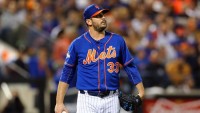
This is a whole new generation. When I was growing up, we had candy cigarettes (gone) and Big League Chew (still around). While playing baseball, we used to have the candy cigarettes so we could smoke like Keith Hernandez, or we would shove a ton of Big League Chew in our mouths to look like Lenny Dykstra. Dykstra was such a legendary chewer that he was said to have stained the AstroTurf at the old Vet.
As kids, we used this stuff because we thought it was cool to look like ballplayers. Did we try to real stuff? Well, not as kids. It’s s good thing too because it would’ve been like that scene in The Sandlot:
https://m.youtube.com/watch?v=CAxuXNxsNMk
Personally, I never really had any interest. Part of the reason was my parents. Another part was I was a catcher. I’ve seen catchers who have used chewing tobacco, but to me that was a pain. I tried seeds, which is similar in principle, but it annoyed me. So I went without any of it for most of my baseball life.
Then I got older, got big, and was moved out from behind the plate. Part of “rookie” hazing was getting them to throw in a dip and watch the hilarity ensue. It wasn’t pleasant.
In any event, I found myself playing that dreaded DH position more and more, which means you spend a lot of time on the bench. Many of those guys throw one in, so you usually do as well. You practice that finger motion with your index finger so you can pack it better and tighter. One day, it all becomes second nature.
When I was in college, it was great. There were a couple of nights, it helped me get through the all-nighters. Also, there were some bars in the area where if you didn’t throw one in, you were out of place. Honestly, I wasn’t so much addicted to it as I loved doing it.
A good friend of mine and me used to love dipping while watching baseball games. We would not only watch the games, but we would also keep an eye out for who was dipping. You would see the finger going in the dugout. The circle shape in the player’s uniform pants. That ever so slight bump in the bottom lip. If you ever saw it in the top lip, you knew that guy was having real problems. Looking at the Mets now, I can tell you who does and who doesn’t dip. I can do that for any team if I watch them long enough.
Eventually, I quit. It really is a nasty habit. More importantly, it’s dangerous. We saw Tony Gwynn die too young because of it. We saw Curt Schilling battle cancer. As much as I enjoyed it, it really wasn’t worth it.
The strange part is I never would’ve started had it not been part of baseball’s culture. No sport is as associated with smokeless tobacco than baseball. I thought about all of this when I saw Tim Rohan’s New York Times article about New York City looking to ban smokeless tobacco from being used in places like Citi Field and Yankee Stadium.
There’s a lively debate to be had here about whether this law is a good idea or not. It’s a debate that should occur. However, at the end of the day, I’m more concerned for that two year old of mine that loves baseball. I realize that NYC can put every law in place they want, but it won’t matter. It doesn’t matter because the problem is baseball.
The city bans smoking, but we hear about Yoenis Cespedes smoking between innings. We see players using smokeless tobacco all over the field. As we see with Cespedes, a player will find a work-around. You should hear how they work around smokeless tobacco bans and stigmas in other sports. Overall, players will always find a way to do it.
If that’s the case, it’ll always be associated with baseball, and that’s not a good thing. Baseball needs to help find a reasonable solution to this because what they have so far isn’t working. They need to figure it out because one day that Big League Chew becomes Skoal or Red Man. That needs to stop before another generation of players starts using it.
I don’t want to see another Tony Gwynn.
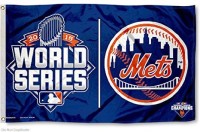
In 2016, the Mets are defending their fifth National League crown. Do you know how the Mets finished their season in their other four attempts? Good luck.

Well, I didn’t quite make it to work today. There’s a simple reason. My son did his best Linda Blair impersonation. I heard him say, “Uh oh” and then vomit all over. I mean all over. He even hit me. It was on my shirt, in my hair. Everywhere.
Worse yet, I was woefully unprepared for it. Like an idiot, I thought these days were done. When my son was a baby, we were always prepared for vomits and blowouts. Now that he’s a toddler? We’re mostly prepared for spilled milk and the like. Well today, I put the provisions back in place, which are:
- Liter of bottle of water
- Dawn paper towels
- Clorox wipes
- Garbage bag
- Paper towels
Seriously, I cannot stress enough the need for the Dawn paper towels. Once you get them wet, it permits you to scrub whatever surface of your car, or child’s clothing with soap and water (the liter that’s in your car). Keep in mind, you don’t need a lot. A little goes a long way. Most of the time, I’ve been able to clean whatever issue was present with the Dawn paper towels. More importantly, you’re going to reduce the smell in the car for when you’re finally going to get back on the road.
The Clorox wipes are to wipe down any toys and the like that are salvageable. I threw away two coloring books today, but I was able to wipe down some toy cars.
Before you depart, you don’t want to leave everything soapy. Use the remaining water and rinse the areas that had to be cleaned with the Clorox paper towels. You want to get rid of a the soap, and you want to make sure you got everything.
It should go without saying, all of the aforementioned steps come AFTER you’ve cleaned off your child.
Overall, I’ve found this kit helps really well. I only wish I had it with me today. I hope now you’ll have it with you.

At the press conference today re-introducing Yoenis Cespedes, the issue of what Alejandro De Aza‘s role will be. Naturally, he’s expected to be on the bench ready, willing, and able to play all three outfield positions. Perhaps, that is jumping the gun a bit:
https://twitter.com/jareddiamond/status/694964819003359232
This really just confirms what every Mets fan thought when De Aza came aboard. De Aza signed with the Mets to share centerfield duties with Juan Lagares. The move was made because the Mets never thought they were going to be able to sign Cespedes. Yet, somehow, Cespedes returned to the Mets leaving behind Lagares and De Aza platooning on the bench.
Now, we are not privy to what, if any, promises were made to De Aza. We do know at the time De Aza was signed, the Mets were fairly steadfast they were not re-signing Cespedes. With that said, it’s fair to say, De Aza came to the Mets to be at worst their fourth outfielder. At a minimum, it appeared he was going to have a legitimate shot to get the bulk of the at bats in centerfield. Now, he’s the team’s fifth outfielder. I’m sure he’s not happy with being pushed down the depth chart without even playing one game, especially when he could’ve signed anywhere.
Now, De Aza can’t be traded until June 15th unless he consents to a deal, which he very well might. While every player wants to win, every player also wants to play. Right now, De Aza’s at bats will be few and far between as he’s the left-handed option off the bench, and the corner outfielders hit left-handed as well. He could be buried on the bench for a while. It’s not exactly an exciting proposition for a 31 year old utility outfielder.
So yes, we understand why De Aza would want to be traded, but why would the Mets want to trade him? With the Brandon Nimmo injury and the Darrell Ceciliani trade, De Aza is it when it comes to organizational centerfield depth. Well, there are a few good reasons.
First, De Aza may not be happy on the bench for long stretches, especially after he thought he could be a starter with the Mets. Having a disgruntled player is never good for your clubhouse. While Terry Collins was quite adept at handling the clubhouse last year, it doesn’t mean you should introduce a potential problem from the start. No, I’m not suggesting De Aza is a bad guy. Rather, I’m saying any player not getting sufficient playing time is an issue that will eventually come to a head.
Another reason you trade De Aza now is this might be the time when he has his most value. As teams look to fill out their rosters as Spring Training and/or the regular season approaches, De Aza may become a more attractive option. The Mets aren’t likely to get much in return, but whatever they do get is most likely to be better than what they get around the trade deadline.
Whether or not the Mets trade De Aza, we should be able to agree on one thing. De Aza is here because the Mets never expected Cespedes to be here. Now the Mets need to find playing time for FIVE major league caliber outfielders. This really is a nice problem to have after the problems we saw with the Mets last year.
Sometimes, it’s great when the plan doesn’t come together.
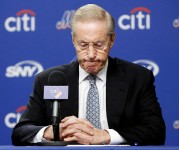
When is a story not a story? I found myself asking that question when I read Deadspin‘s account on the current state of the Wilpon’s real estate business.
For the relatively uninformed Fred Wilpon made his money in the New York City real estate market. He is seen as a shrewd investor and a respected member of the industry. Say what you will about Fred Wilpon and his running of the Mets, but up until this article, his real estate acumen has not come into question.
Normally, I think Deadspin’s article would have been very important and enlightening. As we’ve seen from Howard Megdal’s reporting, the Mets other business interests have affected their ability/willingness to put the most competitive Mets team on the field as possible. However, with the Yoenis Cespedes signing, and the payroll hovering around $140 million, I’m not sure the Mets payroll is a story anymore, at least not with respect to the 2016 season.
While we can quibble with any particular move, it’s hard to attack the Mets for this roster as a whole. They have arguably the best pitching staff in baseball. Of the eight everyday position players, five are former All Stars while the other three could reasonably be All Stars within the next year or so. The bullpen has many pitchers who can handle both righties and lefties well, and it is headlined by a dominant closer.
So yes, the Deadspin report is very newsworthy. However, at least with respect to the 2016 season it’s not really a baseball story. It’s not a reason for any snarky comments. The Mets have spent the money, and they have a complete roster to make another run towards winning the World Series.
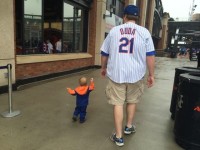
In my life, I’ve actually purchased very few Mets players jerseys. The first was Mike Piazza. After that it was David Wright and then Matt Harvey. I’ve received others as gifts (some requested), but those are at that I’ve purchased.
The one player jersey I always wanted was Daniel Murphy. I never purchased it. It seems that each and every year Murphy was a Met, he was rumored to be out the door. For various reasons a trade never materialized. I didn’t want to buy the jersey only for him to be traded the next day. Well, a funny thing happened. Murphy lasted seven years. He had a signature postseason game. He had the greatest postseason run for any Mets hitter ever. None of that should surprise us because Murphy was always incredibly clutch.
The time to purchase his jersey has passed because he’s gone. Sure, I could purchase one hoping I’ll see him again one day to get that autograph. I could wear it for the day he comes back to Citi Field. The thing is it wouldn’t make sense. Thinking about it, the Wright jersey, albeit outdated, is still good 11 years later. I could purchase another like a Yoenis Cespedes‘ jersey. However, he presents the same problems:
Cespedes is signed, but will he be around long enough to buy his jersey? KP has a flat in NYC for what? Hahn & Humpty next on @ESPNNY98_7FM
— Alan Hahn (@alanhahn) January 28, 2016
So right now, I have two Mets jerseys that’ll serve well for the 2016 season. The aforementioned Harvey jersey and the Lucas Duda jersey my son got me. If I’m going to purchase another, I’ll make sure it’s a player who will likely be around for more than one year.
Hopefully, that player will be with the Mets for at least seven years.
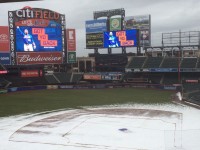
Am I the only one that finds it incredibly fitting that Yoenis Cespedes is being introduced during a rainy day? Remember, it might’ve been a rainy day that brought him here in the first place.
Roughly half a year ago, there was some hope in the Mets season. The team had just acquired Tyler Clippard, Kelly Johnson, and Juan Uribe. Michael Conforto was up with the team and producing well ahead of schedule. Travis d’Arnaud was soon to return. While Mets fans had seen some bad baseball for far too long, things were seemingly getting much better. Then disaster struck.
There was the inexplicable drama surrounding the failed Carlos Gomez trade. Wilmer Flores was left standing on the field crying. Then we discover the trade didn’t happen. The Mets say Gomez failed a physical. The Brewers said the Mets wanted money in the deal. With all that hovering, the Mets took the field for a rainy day game. They had a 7-1 lead going into the seventh, and a 7-5 lead heading into the ninth. The Padres had two outs and Jeurys Familia had an 0-2 count on Derek Norris.
The heavens opened causing the umps to call a rain delay for a game that could’ve ended with one more pitch. The delay nearly lasted an hour. When they game resumed Familia allowed a single to Norris, another single to Matt Kemp, and then a three run homer to one-time trade target Justin Upton. After another rain delay of around two and a half hours, the game resumed seeing the Mets go down meekly 1-2-3 in the ninth. Whatever good feelings and momentum in the season was there, it was seemingly washed away. The fans were angry.
The rains eventually cleared. There would be a new day both literally and metaphorically when the Mets pulled the trigger on the trade for Yoenis Cespedes. Sure the Mets win the NL East without him, but man, the 2015 season had a different feel to it when he came on board. It was a fun run, and now he’s back. We’re ready for another ride.
But first, he’s going to be re-introduced to the fans on a rainy day. Seeing how it was a rainy day that brought him here, I wouldn’t have it any other way.
Welcome back Cespedes.

I still remember the first Mets prospect I followed though the minors. It was Jae Weong Seo, or Jae Seo as he liked to be called.
Unlike recent big leaguers from South Korea, Seo signed a free agent deal right out of high school before he played in the Korean Leagues. He was a big time prospect with a big time repertoire. They thought so highly of him, they gave him $1 million right out of high school. He was a well regarded prospect. He was good he was tabbed to start the 2001 Future’s Game. While he had some injury issues, few questioned if he was going to be a big leaguer.
Seo made his debut in a relief appearance on July 21, 2002. He pitched a the next year he would join the rotation where he would have two disappointing seasons. Then in 2005, Seo appeared to turn his career around at the age of 27.
I thought the seminal moment of his career was going to be the night Rick Peterson challenged Jae Seo to pitch better, to throw harder. Seo seemed to take it to heart. In 2005, Seo went 8-2 with a 2.59 ERA and a 1.107 WHIP in 14 starts. He seemed ticketed for a spot in the rotation on a young and emerging Mets team. Omar Minaya had other ideas. He traded Seo at his peak value for Duaner Sanchez and Steve Schmoll.
Sanchez was a huge part of the Mets bullpen in 2006 until his ill-fated cab ride. Seo, on the other hand, never reached the heights he reached in 2005. He was out of the league two years later, and he returned to his native South Korea. He got to be a part of a championship team with the 2009 Kia Tigers. He set a record with 44 consecutive scoreless innings in 2012. Now, he’s retiring. Apparently, he’s so well-regarded that the team wants him to remain on as a pitching coach.
So no, Seo might not have had the career we all envisioned he might. However, he did have a good career. He won a title. He set records. He earned the respect of his peers along the way. In the end, that’s a great career. One that anyone would admire.
Congratulations on a good career Jae Weong Seo.
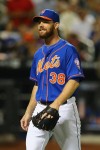
If there’s anything that has been a hallmark of these recent Mets teams it’s that these players get it. Win or lose they acknowledged the fans. They even did it in a moment of heartbreak after losing the World Series. I was again reminded of this when I saw Vic Black‘s recent Tweet:
Thank You New York
Read: https://t.co/AS32hnPqBu
— Victor Black II (@Vic_Black_2) February 2, 2016
In the TwitLonger link, Vic Black acknowledged his New York Mets career was over even if he hasn’t signed with anyone else. He then went on to thank Mets fans for cheering him during his all too short stay with the Mets:
You were kind in welcoming me to YOUR family and I’ll always have blue and orange running in my blood. New York captured my heart and nothing can ever take that away. You gave me a gift, experiences and moments I’ll cherish forever. I’m counting the days till my next visit in whatever capacity that may be. I love you New York!
At first glance, this made me smile. Black was something of a fan favorite. Poor Adam Rubin was inundated with requests for updates on his status. It’s great Mets fans had an impact upon him. It’s even better that he acknowledged our love and returned the love.
It’s funny that it didn’t always start out that way. Black was acquired in the Marlon Byrd trade. At that time, Byrd was something of a fan favorite himself, and he was being traded for a second base prospect, Dilson Herrera, and a live bullpen arm in Black. A lot of the qualms with that trade went away when Black began pitching with the Mets.
In his two years with the Mets, Black was a good and improving reliever. In his 56 appearances, he had a 2.83 ERA, 125 ERA+, 3.65 FIP, 1.259 WHIP, and an 8.3 K/9. He had a blazing 97 MPH fastball. Unfortunately, he would have a neck injury in 2015, suffer a setback in April, and he would never be recalled to the majors. He was unceremoniously removed from the 40 man roster and made a minor league free agent. It didn’t matter that Black regained his fastball. It didn’t matter that he has been a good reliever who is still just 27.
Apparently, Black wants to be back, and Mets fans want him back. Personally, I want him to return, even if it appears he won’t. Whenever he lands, that team is getting a good reliever and an even better person. When he comes back to New York and he comes running out of the bullpen, I’ll be cheering for him.
Good luck Vic Black.

